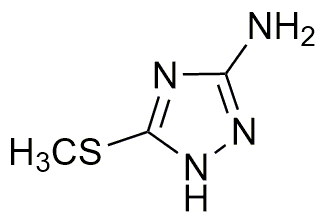3-Amino-5-methylthio-1H-1,2,4-triazole is widely utilized in research focused on:
- Agricultural Chemistry: This compound is used as a plant growth regulator, enhancing crop yields and improving resistance to environmental stressors, which is crucial for sustainable agriculture.
- Pharmaceutical Development: It serves as a building block in the synthesis of various pharmaceuticals, particularly in developing antifungal agents, providing an efficient pathway for drug discovery.
- Biochemistry Research: Researchers utilize this compound to study enzyme inhibition mechanisms, aiding in the understanding of metabolic pathways and potential therapeutic targets.
- Material Science: It is employed in the formulation of specialty polymers and coatings, enhancing material properties such as durability and chemical resistance.
- Environmental Science: The compound is investigated for its potential in bioremediation processes, helping to break down pollutants and restore contaminated environments.
General Information
Properties
Safety and Regulations
Applications
3-Amino-5-methylthio-1H-1,2,4-triazole is widely utilized in research focused on:
- Agricultural Chemistry: This compound is used as a plant growth regulator, enhancing crop yields and improving resistance to environmental stressors, which is crucial for sustainable agriculture.
- Pharmaceutical Development: It serves as a building block in the synthesis of various pharmaceuticals, particularly in developing antifungal agents, providing an efficient pathway for drug discovery.
- Biochemistry Research: Researchers utilize this compound to study enzyme inhibition mechanisms, aiding in the understanding of metabolic pathways and potential therapeutic targets.
- Material Science: It is employed in the formulation of specialty polymers and coatings, enhancing material properties such as durability and chemical resistance.
- Environmental Science: The compound is investigated for its potential in bioremediation processes, helping to break down pollutants and restore contaminated environments.
Documents
Safety Data Sheets (SDS)
The SDS provides comprehensive safety information on handling, storage, and disposal of the product.
Product Specification (PS)
The PS provides a comprehensive breakdown of the product’s properties, including chemical composition, physical state, purity, and storage requirements. It also details acceptable quality ranges and the product's intended applications.
Certificates of Analysis (COA)
Search for Certificates of Analysis (COA) by entering the products Lot Number. Lot and Batch Numbers can be found on a product’s label following the words ‘Lot’ or ‘Batch’.
*Catalog Number
*Lot Number
Certificates Of Origin (COO)
This COO confirms the country where the product was manufactured, and also details the materials and components used in it and whether it is derived from natural, synthetic, or other specific sources. This certificate may be required for customs, trade, and regulatory compliance.
*Catalog Number
*Lot Number
Safety Data Sheets (SDS)
The SDS provides comprehensive safety information on handling, storage, and disposal of the product.
DownloadProduct Specification (PS)
The PS provides a comprehensive breakdown of the product’s properties, including chemical composition, physical state, purity, and storage requirements. It also details acceptable quality ranges and the product's intended applications.
DownloadCertificates of Analysis (COA)
Search for Certificates of Analysis (COA) by entering the products Lot Number. Lot and Batch Numbers can be found on a product’s label following the words ‘Lot’ or ‘Batch’.
*Catalog Number
*Lot Number
Certificates Of Origin (COO)
This COO confirms the country where the product was manufactured, and also details the materials and components used in it and whether it is derived from natural, synthetic, or other specific sources. This certificate may be required for customs, trade, and regulatory compliance.


